MDM Implementation Styles
Effective master data management (MDM) requires a clear implementation plan and an appropriate implementation style that fits the needs of the business. Four MDM implementation styles are common, Registry model, Consolidation model, Coexistence model, and Centralized model, with a fifth model, E-Synchronization model, that is the latest evolving model with deeper connections into e-commerce platforms to accommodate increasing consumer preferences for online shopping.

Preliminary implementation model considerations
Three factors help to broadly categorize which implementation style will be appropriate for a business.
- Cost — Cost is typically the first and last consideration in choosing an implementation style. Registry models tend to be less complex, or intensive, therefore less expense. From there, the models can be upgraded to other models appropriate for needs. A Registry model can be upgraded to a Consolidation model, for example, with all the accompanying stewardship features added with greater data scrutiny. Costs are important, but the correct style is measured by business goals and needs.
- Data Sources — The number of data sources is another concern. Businesses with large numbers of data sources, for example, can benefit from the Registry model. Multiple sources present data accuracy challenges, but by fetching data from all sources and depositing them in the MDM hub, then applying cleansing and matching algorithms, these systems can reconcile duplicates, and form a single-source of truth, or “golden record”.
- Data Scrutiny — Based on the two factors above, Registry implementation style seems to win out, it is both the cheapest, and can easily form a golden record from multiple data sources. However, the Registry’s golden record is not 100% accurate, it’s an approximation made by computer algorithm. If greater data scrutiny is required (see Match and Merge Concepts section), then a human eye can review data and determine accuracy more closely. These systems use additional stewardship features, and therefore cost more.


Elements in MDM implementation styles
The following five elements help determine the characteristics of each implementation style.
- Data Authors — Data authors are those who originate data into the system. Two locations are important in determining an implementation style, originating information at data sources, and/or originating data at the MDM hub.
- Source Systems — How many data sources are there? Will those data sources be looped back into the MDM and synced in real-time?
- MDM Platform — While the MDM platform plays the most prominent role in keeping a golden record, depending on the implementation style, the MDM hub may share data with source systems or simply use them to compile a master record leaving them untouched in place.
- Data Destinations — Data doesn’t pool in MDM simply to be archived, it must be analyzed and shared with other business systems. Third-party marketing and advertising systems are a common data destination, and e-commerce systems are becoming prominent MDM data destinations.
- Data Stewardship — Data stewards are those people who are responsible for a particular data set’s integrity. They are able to review and adjust the golden record to correct errors and enhance accuracy beyond the algorithms.
Registry MDM Implementation Style
The first style, the Registry model, is well suited for rapidly ingesting data from multiple sources. If the business is in need of a low cost and quick solution for developing a golden record, Registry systems can do this by applying algorithms to cleanse data before it is stored in the MDM platform. From the MDM the master data can be read (only), or sent to downstream data users and applications. Because data at the sources is not updated from the MDM registry, source data systems remain unchanged, providing a historic record of all uncleansed data.
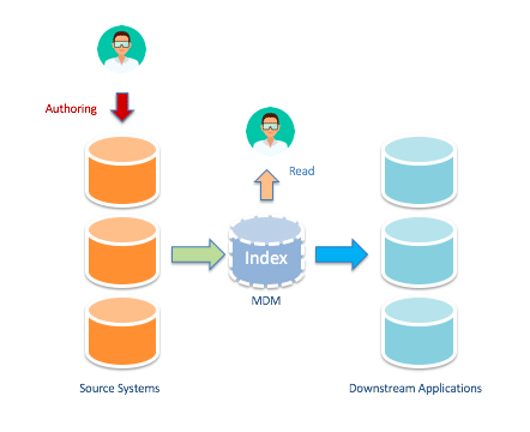
Match and Merge Concepts
When data is fetched from multiple sources, to create a golden record it must be matched and then merged together with similar records into a single final record in the MDM’s golden record. The following illustration shows that a match and merge algorithm will determine similarities between data entries based on fields. Some attributes, like DOBs and SSNs, are more significant for identification and therefore weighted heavier as identifiers (names are less of an identifier because of their shared commonality). A match score is used to determine the credible uniqueness of similar entries. If an entry is inadequately matched but seems as a likely fit, it can be relegated to data stewards for further inspection.
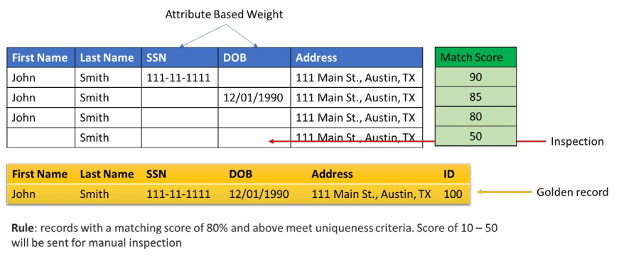
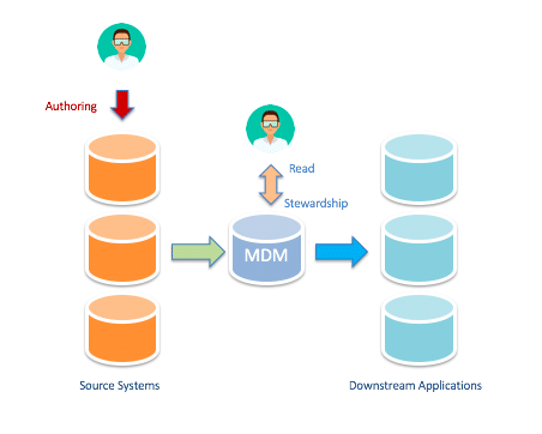
Consolidation MDM Implementation Style
The Consolidation MDM implementation style is an upgraded Registry style with an added layer of data stewardship. Consolidation models are suited for multiple sources, and follow the same data pipeline procedures as the Registry model. Multiple data sources are consolidated into the MDM hub where algorithms cleanse data and questionable data is then inspected by human data stewards who can make appropriate corrections. In this way, data accuracy passes through a layer of human wisdom unavailable to computers, resulting in greater data accuracy. Greater data accuracy is helpful in supporting the high quality analytics and reported features found in consolidated models.
Coexistence MDM
Implementation Style
Beginning with a Consolidated model, Coexistence MDM implementation styles build loopback features into the MDM system that updates source systems with Master Data records. This results in a Master Data record in both the hub and the upstream data sources. This helps authors retain the most updated information at the sources. This configuration demands that sources have cleansing features to ensure data integrity.
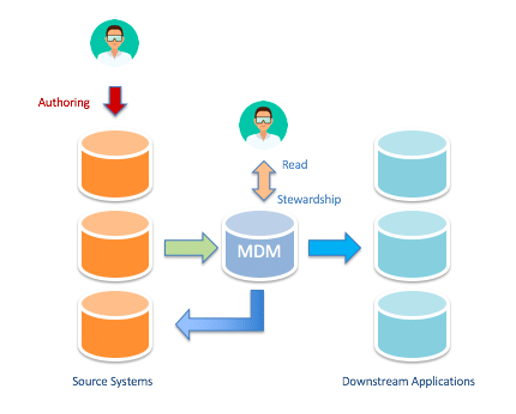
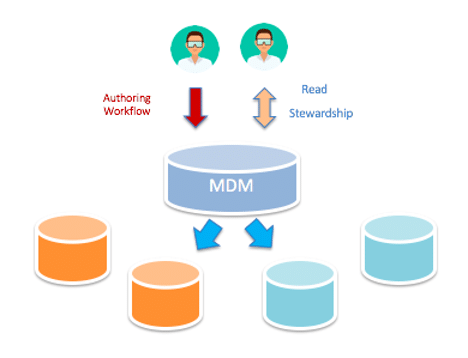
Centralized MDM
Implementation Style
A Centralized MDM implementation style offers maximum control over security, visibility policies, and ownership of master data from the MDM hub, allowing no other system to adjust the master data record. Authors originate data at the hub; stewards review questionable records at the MDM hub. There are no sources, only data destinations that subscribe to the MDM for master data. Centralized systems are the most accurate at all times across all domains with the price tag to prove it.
How to Implement an MDM Solution
Because an MDM solutions implementation guide is beyond the scope of this article, presented below is a general outline to help businesses begin their MDM implementation journey. Universal among implementation experts is the idea that clear and carefully thought out planning is essential to a successful implementation. To make that task easier, consider the following points before setting out to implement any of the styles..
- Conduct an Initial assessment of the current data management infrastructure and efforts.
- Begin with Implementation Preparations
- Define Business Goals
- Define Success Criteria Metrics
- Devise Strategy and Roadmap
- Recruit and Executive Sponsor that will energize MDM efforts throughout the organization and a Application Owner who will maintain the MDM application.
- Establish a Data Governance Council to devise and review governance rules
- Follow with System and Data Preparation
- Identify Master Data
- Identify Data Sources and Data Destinations of Master Data
- Establish Enforceable Data Governance Rules in the system
- Establish Master Data Metadata
Change management in implementation
Change management is an important concept in MDM implementation because taking a master data approach to an organization’s data assets not only involves technology and process, but chiefly the people who will be implementing and using master data. Staff need to take a data-first approach to operations, meaning they rely on data, make data-driven decisions, and overall seek to derive value from the data produced by the company about itself. Depending on their familiarity and comfort with using data, high or low, it can foreshadow the change journey ahead.
Change management is a structured process for implementing new operations within organizations. The discipline is so important that it continues to attract many hours of professional study, but central to every school of thought on change management is “inclusion”. Without involving the majority, if not entirety of stakeholders, change management bogs down, invites confusion, and becomes ineffective.
One simple example of why this occurs when implementing new technology is that often new technology becomes the focus because it seemingly delivers value to data processes, and ignores the fact that people will remain the users, stewards, and support staff that will maintain the data processes. In short, the people are the purpose of the data, and the driving force of it, technology helps with this but is a tool.

Learn how Reltio can help.
